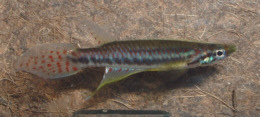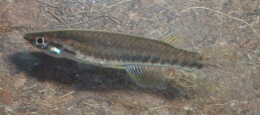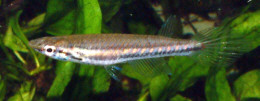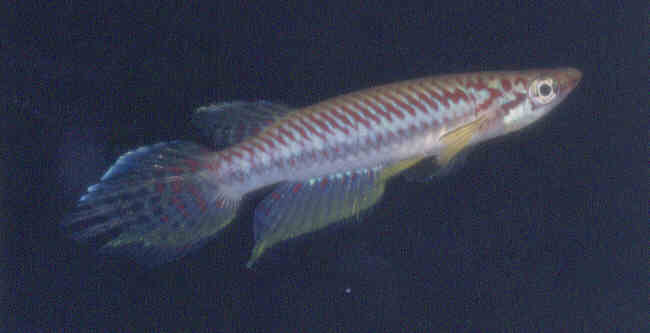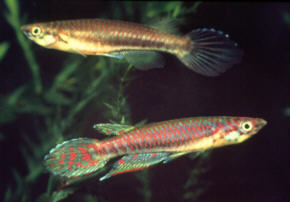Epiplatys bifasciatus (Steindachner 1881)
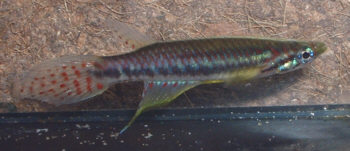
TAAG 2003 / 7 male.
| Meaning of Name |
After the two horizontal stripes down the body. | ||||||
| First Description |
Steindachner F. 1881. Ichthyologische Beiträge (X).Sitzungsberichte der Kaiserlichen Akademie der Wissenschaften in Wien, Abteilung I (Mathimatische-naturwissenschaftliche Classe) 83: p 199-200. | ||||||
| Size |
7 cm | ||||||
| Meristics |
| ||||||
| Karyotype |
n = 20, A = 23, 24 (Scheel 1968, 1974) | ||||||
| Sub-Genus |
Epiplatys | ||||||
| Group |
bifasciatus | ||||||
| Synonyms |
| ||||||
Populations
|
| ||||||
| Type Locality |
Originally given as Bahr el Gebel (sometimes seen as Jebel) but is now called Bahr el Zeraf (white Nile & it's tributary) (southern central Sudan). | ||||||
| Distribution |
A very large area of distribution between Senegal in
the west & Sudan in the east of Africa. http://homepage.uibk.ac.at/homepage/c102/c102mr/epiplaty/bifascia.htm | ||||||
| Habitat |
Variable over such a large distribution area, but they have been found in areas of aquatic vegetation in rivers & swampy areas of savannah. Also found in coastal lagoons. This sp. favours savannah areas. | ||||||
| Distinguishing Characteristics | Two stripes running horizontally down the body. This may not be clearly seen on some populations though. | ||||||
| Colour/Pattern Variability | |||||||
| History |
Described by Steindachner in 1881 from material caught at Bahr-el-Gebel in the Nile drainage. Boulenger gives the following collectors / locations in his 1915 Catalogue.
Imported by the BKA from a collection by David Blair 1969/70. Dick Cox (BKA) had a small import of 6 pairs from Togo on the 25th September 1974. These were distributed in the BKA through the species controller. History of the synonym Haplochilus baudoni Pellegrin 1922 Pellegrin
described this sp. in 1922 from a single specimen collected at Fort Crabel in
the Gribingui-Shari-Chad drainage area. History of the synonym Panchax taeniatus Pfaff 1933 Pfaff
described this sp. from 4 specimens collected from Jebba on the Niger River, northern
Nigeria. He placed this sp. closest to bifasciatus
but seperated it on the grounds of a larger number of fin rays in the dorsal &
larger number of scale counts around the body. History of the synonym Panchax steindachneri Svensson 1934 Svensson described this sp.
from around 50 specimens collected in swamps from the McCarthy Island area of
Gambia. He based this description on differences noted by Steindachner in Haplochilus
senegalensis Steindachner 1870 (see E.spilargyreius).
He did mention that they resembled E.bifasciatus
from the Nile, Sierra Leone & Cameroon. History of the synonym E.ndelensis Fowler 1949 Fowler described this species from three specimens collected near Ndele, Ubangui-Shari, Chad drainage. This area is situated at the western foot of the Bongos Mountains, Central African Republic at the Bangoran River, an affluent of the Shari River. Fowler's largest specimen studied was only 25 mm in length. | ||||||
| Breeding Notes |
Regarded
as a difficult species to breed in some literature but I found them fairly easy.
Eggs take around 14 days to water incubate. Newly hatched fry are small &
do best on infusoria as a first food for a few days. Sexual maturity is slow coming
at 7-8 months. Will adapt & breed in hard alkaline water. I used was tapwater, pH 8.0, DH 10. | ||||||
| Diameter of Egg | |||||||
| Remarks |
Water changes should be given slowly as this species is sensitive to sudden water change. |
